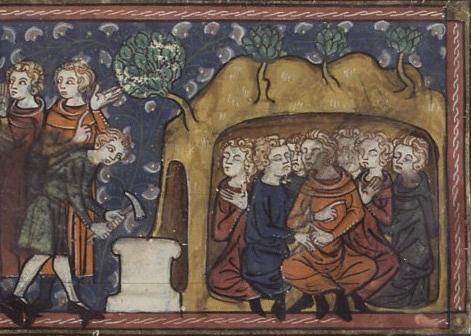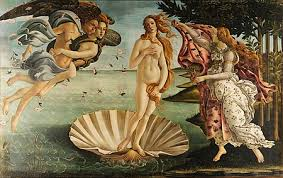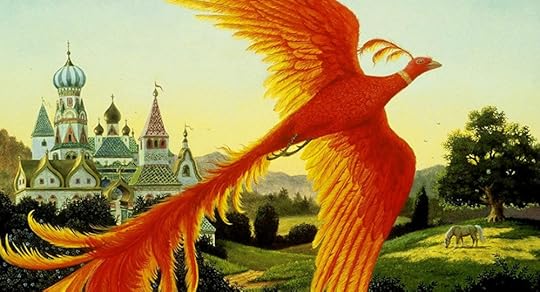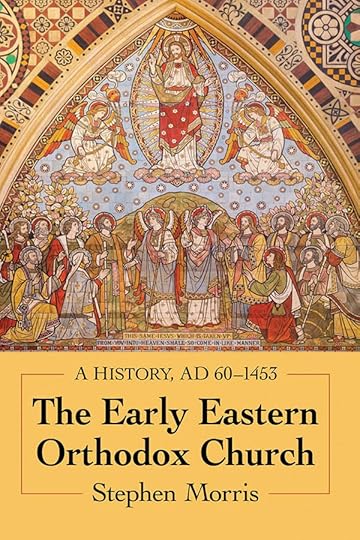Stephen Morris's Blog, page 26
August 13, 2018
St. Lawrence on the Griddle

Medieval illumination of St. Lawrence being roasted to death.
As archdeacon of Rome, St Lawrence was responsible for the material goods of the Church and the distribution of alms to the poor. During the persecution of Christians in AD 258, he was arrested and told that the financial resources of the Roman Church–which the judge suspected was quite considerable–would be confiscated but he would be spared from execution if he would help gather the Church’s resources for the imperial authorities. Lawrence said that he would need three days to gather all the wealth of the Church and bring it to the court; he was released, with the understanding that he would came back to the court in three days with the wealth of Roman church.
Three days later, Lawrence came back to the court at the head of a large crowd of the old, the ill, the crippled, the orphaned, and the destitute. The judge asked where the Church’s treasure was. Lawrence pointed to the people behind him and answered, “These are the treasures of the Roman Church.” He went on to say, “Behold in these poor persons the treasures which I promised to show you. In addition to these, I will add pearls and precious stones, those widows and consecrated virgins, which are the Church’s crown.” The judge was so angry that he had a great gridiron prepared with hot coals beneath it, and had Lawrence placed on it, hence St Lawrence’s association with the gridiron. After the martyr had suffered pain for a long time, the legend concludes, he cheerfully declared: “I’m well done on this side. Turn me over!”
In many places, the feast of St. Lawrence–August 10–is the end of the summer harvest and the beginning of sowing the winter crops (such as rye). Because of his quip on the gridiron, Lawrence is the patron of cooks, chefs, and comedians. In some parts of eastern Europe, Lawrence the archdeacon was also a patron of horses because he was confused with Laurus the saint associated with horse doctors.
The post St. Lawrence on the Griddle appeared first on Stephen Morris, author.
August 6, 2018
Seven Sleepers

Illuminated manuscript from the 14th century shows the seven sleepers being walled into the cave.
In Christian and Islamic tradition, the Seven Sleepers of Ephesus is the story of a group of seven youths who hid inside a cave outside the city of Ephesus around 250 AD to escape a religious persecution. The fell asleep and came out of the cave 300 years later.
The story says that during the persecutions by the Roman emperor Decius, around 250 AD, seven young men were accused of following Christianity. They were given some time to recant their faith, but chose instead to give their worldly goods to the poor and retire to a mountain cave to pray, where they fell asleep. The emperor, Decius, ordered the mouth of the cave to be sealed.
Decius died in 251, and many years passed during which Christianity went from being persecuted to being the state religion of the Roman Empire. At some later time – usually given as during the reign of Theodosius II (408–450) – the landowner decided to open up the sealed mouth of the cave, thinking to use it as a cattle pen. He opened it and found the sleepers inside. They awoke, imagining that they had slept but one day, and sent one of their number to Ephesus to buy food, with instructions to be careful lest the pagans recognize and seize him.
Upon arriving in the city, this person was astounded to find buildings with crosses attached; the townspeople for their part were astounded to find a man trying to spend old coins from the reign of Decius. The bishop was summoned to interview the sleepers; they told him their miracle story, and died praising God.
The survival of the Seven Sleepers in the cave was taken as proof of the possibility of the general resurrection of the dead, which some were denying in the fifth century. The Seven Sleepers were invoked by people suffering terrible nightmares. Their aid was also sought by people suffering insomnia or who could not sleep because of great pain or other illness.
The story appears in Christian collections of saints’ lives and in the Qur’an (Surah Al-Kahf, verse 9–26) and is thus important to Islam. The Quranic story does not state the exact number of sleepers, but gives the number of years that they slept as 300 solar years (equivalent to 309 lunar years). The Islamic version includes mention of a dog who accompanied the youths into the cave and appears to keep watch. In Islam, these youths are referred to as “The People of the Cave”.
The flag of Kelantan in the 19th century, located in present-day Malaysia, incorporated elements from the Islamic interpretation of the story. In the surah, the dog is believed to act as a guardian, looking out for the believers until they awake.
See more icons of the Seven Sleepers here.
The post Seven Sleepers appeared first on Stephen Morris, author.
July 30, 2018
Scallop Shells and Saints

A scallop shell marks the pilgrimage route to Santiago.
The scallop shell is the traditional emblem of St James the Great and is popular with pilgrims returning from the Way of St James (Camino de Santiago) and the apostle’s shrine at Santiago de Compostela in Galicia, Spain. Medieval Christians would collect a scallop shell while at Compostela as evidence of having made the journey. The association of Saint James with the scallop can most likely be traced to the legend that the apostle once rescued a knight covered in scallops. An alternative version of the legend holds that while St. James’ remains were being transported to Galicia (Spain) from Jerusalem, the horse of a knight fell into the water, and emerged covered in the shells.
In French the animal (as well as a popular meal of it in cream sauce) is called coquille St. Jacques. In German, they are Jakobsmuscheln – literally “James’ mussels”. When referring to St James, a scallop shell is displayed with its convex outer surface showing. In contrast, when the shell refers to the goddess Venus (who stepped out from the sea on a scallop shell), it is displayed with its concave interior surface showing.

Sandro Botticelli, The Birth of Venus (c. 1484-86). Tempera on canvas. Uffizi, Florence
The post Scallop Shells and Saints appeared first on Stephen Morris, author.
July 23, 2018
Pilgrimage to Santiago

The Botafumeiro is a famous thurible found in the Santiago de Compostela Cathedral. In the past, similar devices were used in large churches in Galicia; one is still used in the Tui Cathedral. Incense is burned in this swinging metal container, or “censer”. The name “Botafumeiro” means “smoke expeller” in Galician.
The Camino de Santiago known in English as the Way of Saint James is a network of routes and pathways for pilgrims to the shrine of the apostle Saint James the Great in the cathedral of Santiago de Compostela in Galicia in northwestern Spain, where the remains of the saint are buried.
The Way of St. James was one of the most important Christian pilgrimages during the Middle Ages, together with those to Rome and Jerusalem. Canterbury (which had the shrine of St. Thomas Becket) was the fourth most popular pilgrimage.
Legend holds that St. James’s remains were carried by boat from Jerusalem to northern Spain, where he was buried in what is now the city of Santiago de Compostela. (The name Santiago is the local Galician evolution of Latin Sancti Iacobi, “Saint James”.)
During the Middle Ages, the route was highly travelled. However, the Black Death, the Protestant Reformation, and political unrest in 16th century Europe led to its decline. By the 1980s, only a few hundred pilgrims per year registered in the pilgrim’s office in Santiago. However, since the 1980s the route has attracted a growing number of modern-day international pilgrims.
Today, hundreds of thousands (over 200,000 in 2014) of Christian pilgrims and many others set out each year from their front doorsteps or from popular starting points across Europe, to make their way to Santiago de Compostela. Most travel by foot, some by bicycle, and some travel as some of their medieval counterparts did, on horseback or by donkey (for example, the British author and humorist Tim Moore). In addition to those undertaking a religious pilgrimage, many are hikers who walk the route for other reasons: travel, sport, or simply the challenge of weeks of walking in a foreign land. Also, many consider the experience a spiritual adventure to remove themselves from the bustle of modern life. It serves as a retreat for many modern “pilgrims”.
There is a famous church in Prague also dedicated to St. James.
The post Pilgrimage to Santiago appeared first on Stephen Morris, author.
July 17, 2018
St. James the Moor-slayer

Statue of Saint James the Moor-slayer or Santiago Matamoros in the Cathedral of Burgos, Castille, Spain
Tradition has it that the Apostle Saint James preached in Spain. He then returned to Jerusalem, where Herod executed him. The corpse was then placed in a ship that arrived at Spain. The tomb was forgotten until the year AD 813, when a hermit noted lights and songs around the place. The hermit told the local bishop who–after removing some weeds–discovered the remains of the apostle identified by the inscription on the tombstone. He reported the discovery to King Alfonso II, who came to the scene and proclaimed the Apostle Sant Iago (Saint James) patron of the kingdom. The area was then renamed as Campus Stellae, the “Field of Stars,” from which the current name, Compostela, has been derived.
During the Battle of Clavijo, it is said that Saint James the Great miraculously appeared to provide assistance to an outnumbered Spanish Christian army, helping them gain victory against the Moors who had started their conquest of Spain in AD 711. The battle is placed between AD 834 and 844, about 800 years after the death of James. According to legend, Saint James appeared as a warrior on a white horse amidst the Spanish army, wielding a white banner. Upon seeing him, the Christian army cried out “¡Dios ayuda a Santiago!” which translates to “God save St. James!” It is believed that more than 5,000 Moors were killed during the battle, earning James the title Matamoros or “Moor-slayer”.
Many historians argue that the Battle of Clavijo never took place and that it was a myth based on the historical Battle of Monte Laturce (AD 859). The legend only appeared in writing nearly 300 years after its alleged occurrence. However, while it was based on legend, the story of the battle helped establish Spain’s national identity.
See an article from The Guardian about St. James the Moor-slayer here.
The post St. James the Moor-slayer appeared first on Stephen Morris, author.
July 9, 2018
Flying Carpets

Riding a Flying Carpet, an 1880 painting by Viktor Vasnetsov
Flying carpets seem to be the single most famous object in the Abrian Nights stories. well, flying carpets and magic lamps. But everyone knows flying carpets fill the stories of the Arabian Nights.
Or do they? I just read a fascinating essay by Ruth B. Bottigheimer in the most recent issue of Gramarye, the journal of the Sussex Centre for Folklore, Fairy Tales, and Fantasy. Bottigheimer points out that only a few of the Arabian Nights tales include flying carpets and those tales are all late additions to the collection. A flying carpet first appears in the tale Prince Ahmed and Pari Banou which was written by Hanna Dyab, a Syrian Christian who travelled to Paris and wrote his story after reading French fairy tales. His story follows a basic European fairy tale plotline which is different from the usual plots of the Arabian Nights tales.
The tale of Prince Ahmed and Pari Banou is based on a French story by Madame d’Aulnoy called White Cat. The French story has a beautiful carpet that does not fly and so a beautiful carpet appears in Pari Banou as well. But there is a wooden horse that can fly in the White Cat story and so the beautiful carpet in Pari Banou DOES fly. Before Hanna Dyab retold White Cat, the only Arabic mention of “magical carpets” were actually wooden platforms in the Koran which says that King Solomon was able to control the wind and travel great distances in a single day, with a large wooden platform travelling with him to carry all his servants, possessions, and soldiers.
Jewish stories from the Middle Ages also say that King Solomon was given the power to control the winds by God. In the Jewish stories, Solomon rides a green carpet with all his servants. But these Jewish stories were apparently unknown to Arabic storytellers. It seems that one of the most apparently Arabic magic objects–flying carpets–actually came from a Syrian Christian who retold a French fairy tale to the man collecting the Arabian Nights stories.
The post Flying Carpets appeared first on Stephen Morris, author.
July 2, 2018
Executions

Ancient lithography representing the elements of devotional practices towards the holy souls of the executed in Sicily.
June 29, 1972 – The U.S. Supreme Court ruled (5-4) that capital punishment was a violation of the Eighth Amendment prohibiting “cruel and unusual punishment.” The decision spared the lives of 600 individuals then sitting on death row. Four years later, in another ruling, the Court reversed itself and determined the death penalty was not cruel and unusual punishment. On October 4, 1976, the ban was lifted on the death penalty in cases involving murder.
Executions and the corpses of the executed have always fascinated people. Stories about the corpses fill books of folklore, legends and mythology. A hanged man’s hand was used to cure warts and skin tumors in England. All sorts of body parts were used in magic and medicine and these were taken from the corpses of the executed either by the executioner or by people who came to unearth and exhume the bodies of the executed in graveyards.
Prayers, folklore and customs from Southern Italy testify that even the souls of criminals had their part in the devotional practices of the population. Invoking the holy souls of the executed who dwelled for a long time in Purgatory, people established a compassionate connection between the actual and the heavenly world. The Catholic and political context of places like 19th-century Sicily, where the bandit might be seen as a popular hero who opposed the Bourbon oppressor, strongly connotes the concept of “holy soul”.
The post Executions appeared first on Stephen Morris, author.
June 25, 2018
“In the Forest, Deep and Dark….”

It’s increasingly rare to find a forest that hasn’t been shaped by human use. Ohikulkija/CC BY-SA 3.0
When I was small, there was a tremendous forest across the field from my great-grandmother’s house on San Juan Island. I called it the Black Forest, after the famous fairy-tale forest in Germany. It was everything I ever imagined a fairy tale forest would be and never went more than a few feet into the trees. I was terrified of becoming lost and wandering in the woods. I was certain that either Baba Yaga or the gingerbread-house witch would find us if we ever wandered too far under the great trees.
Forests are big, dark, and mysterious. They appear in many–if not most–fairy tales. Forests hide Big Bad Wolves. Witches hide their gingerbread houses in forests. Castles that belong to mysterious strangers are surrounded by forests. Sometimes the forest is itself enchanted. Forests are always dangerous and places of adventure that mark the edges of this world and the worlds of spirit and imagination.
Facts, folklore, superstitions, myths, and anecdotes about trees and forests have always fascinated us. A wonderful book came out recently, Forests in Folklore and Mythology, that makes these tales available all in one place and examines the threads or traits they have in common. Customs, temples and sacred groves; mythical forest creatures such as witches, fairies, demons, wood spirits, and wood nymphs are all in its pages.
Certain kinds of trees are associated with wisdom, life, or death. Celtic mythology tells us that birch trees are important in both the winter and summer to purify the world. Birches were celebrated during the festival of Samhain (what is now Hallowe’en)–bundles of birch twigs were used to drive out the spirits of the old year. Later this would evolve into the ‘beating the bounds’ ceremonies in local parishes, a festival in the springtime. Gardeners still use the birch brooms to ‘purify’ their gardens.
According to Atlas Obscura, the last of the great fairy tale forests can be found in Finland, or on the Carpathian or Balkan mountain ranges that slice across Romania and Bulgaria.
The post “In the Forest, Deep and Dark….” appeared first on Stephen Morris, author.
June 15, 2018
Now Available for preorder
“It seemed good to the Holy Spirit and to us,” the apostles declared at the conclusion of their council described in Acts 15. This apostolic council was the first of many councils to come as Christians sought to discern the will of God in the midst of historic challenges.
The faithful continued to struggle to express their new apostolic faith in new words, new languages, new places and new times. Many issues—the interaction of science and faith, divinity and humanity, Church and State—continue to be pertinent today.
This book (published by McFarland, 2018) tells the story of these struggles from the days of the New Testament to the fall of the city of Constantinople in AD 1453. It focuses on the Christian community in the eastern Mediterranean which eventually became known as the Byzantine Empire. Each chapter examines the personalities and theologies entwined at the heart of conflicts that shaped the medieval world as well as the modern cultures of Greece, the Middle East and Eastern Europe.
Order your copy here!
Please be sure to “FOLLOW” me here in order to receive notifications as new books become available.
The post Now Available for preorder appeared first on Stephen Morris, author.
Firebird

Ivan Bilibin’s illustration to a Russian fairy tale about the Firebird, 1899.
Russian composer Igor Stravinsky (1882-1971) was born on June 17 near St. Petersburg. Among his best known works, the ballets The Firebird (1910), Petrushka (1911) and The Rite of Spring (1913), and the choral work Symphony of Psalms (1930).
The Firebird character is one of the most poplar in Russian fairy tales. The Firebird is essentially a phoenix, a golden immortal bird that is reborn from its own incinerated ashes. Its flames and beauty save a variety of heroes and heroines–often princes and princesses–from evil wizards and devils, as in the famous Stravinsky ballet. Some tales say that the Firebird never eats but only sips dew. It saw Adam and Eve expelled from Paradise and is often a messenger between humans and the Otherworld.
One story about the Firebird tells us that a modest and gentle orphan girl named Maryushka lives in a small village. People would come from all over to buy her embroidery, and many merchants asked her to come away and work for them. She told them all that she would sell to any who found her work beautiful, but she would never leave the village of her birth. One day the evil sorcerer Kaschei the Immortal heard of Maryushka’s beautiful needlework and transformed himself into a beautiful young man and visited her. Upon seeing her ability he became enraged that a mere mortal could produce finer work than he himself possessed. He tried to tempt her by offering to make her Queen if she would embroider for him alone, but she refused saying she never wanted to leave her village. Because of this last insult to his ego he turned Maryushka into a Firebird, and himself into a great black Falcon, picked her up in his talons, and stole her away from her village. To leave a memory of herself with her village forever she shed her feathers onto the land below. As the last feather fell Maryushka died in the falcon’s talons. The glowing rainbow feathers were magic and remain undimmed, but show their colors only to those who love beauty and seek to make beauty for others
The Firebird concept has parallels in Iranian legends of magical birds, in the Brothers Grimm fairy tale about The Golden Bird. In an Armenian tale, the Firebird does not burn but rather makes the land bloom through its song. In Czech folklore, it is called Pták Ohnivák (Fire-like Bird) and appears, for example, in a Karel Jaromír Erben fairy tale, also as an object of a difficult quest. Moreover, in the beginning of this fairy tale, the bird steals magical golden apples belonging to a king and is therefore pursued by the king’s servants in order to protect the precious apples.

The post Firebird appeared first on Stephen Morris, author.




